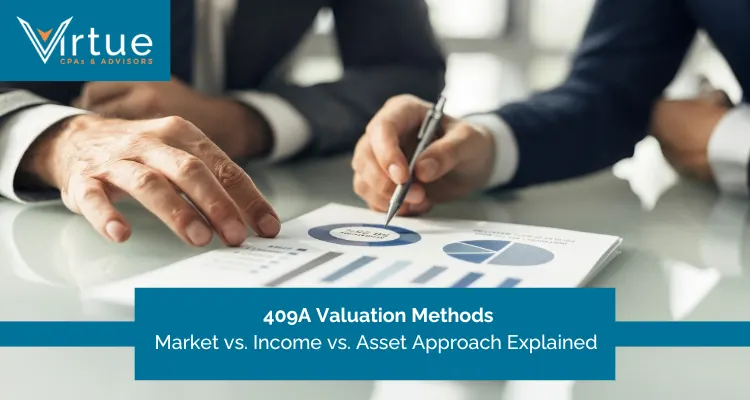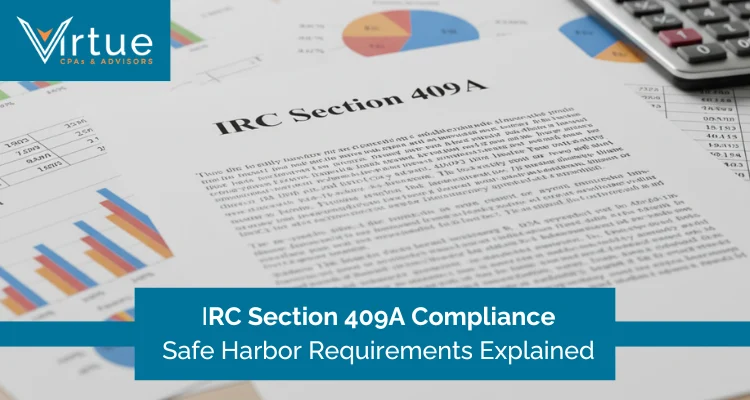You’re building a startup, or maybe you already have one, and you want to reward your team with equity.
But how do you decide how much each share is worth?
That’s where a 409A valuation comes in.
A 409A valuation isn’t just a box to tick—it’s the foundation of fair stock option pricing, IRS compliance, and employee trust.
At Virtue CPAs , we’ve guided countless startups through the valuation process, ensuring they stay compliant while understanding what truly drives their company’s worth.
In this article, you’ll explore the three key 409A valuation methods—Market, Income, and Asset—and learn how to choose the right one for your startup.
Let’s dig in!
What is a 409A Valuation?
A 409A valuation is an independent assessment of the fair market value (FMV) of a private company’s common stock.
It’s named after Section 409A of the U.S. Internal Revenue Code, which regulates how stock options and other deferred compensation are taxed.
The reason you need it is that when you grant stock options (to employees, advisors, etc.), the exercise price you set must be at or above the FMV of the shares on the grant date.
If you set it lower, the IRS can penalize employees.
So, a 409A valuation gives you a defensible, “safe harbor” estimate of what each share is worth, under IRS-approved methods.
Virtue CPAs specializes in performing these valuations accurately and defensibly, giving your startup “safe harbor” protection from IRS scrutiny.
Why 409A Valuations Matter for Startups
You might wonder, do startups really need this?
The answer is yes—for several reasons:
- Tax compliance & risk mitigation: If your options are priced too low, employees could face back taxes, interest, and penalties. A proper 409A protects both you and your team.
- Credibility with investors: Investors want to know that your valuation practices are legitimate and defensible.
- Fairness & morale: You don’t want early team members getting disadvantaged by later ones due to unfair pricing.
- Legal and audit safety: If the IRS ever audits, you’ll want to show that your valuation followed standard methods.
When Do You Need a 409A Valuation?
You don’t do it only once. Here are common triggers:
- Before issuing new stock options or RSUs: You must set a strike price on the grant date.
- Annually: Most companies update their valuations every 12 months.
- When a “material event” occurs: A material event is anything that can significantly change your business’s value—like raising a funding round, a major acquisition, a pivot, or changes in business model or forecasts.
- Before going public or being acquired: You’ll want current valuations for due diligence.
Virtue CPAs helps founders navigate these challenges by providing valuations that satisfy legal requirements and investor expectations—all while aligning with your growth goals.
Key Stakeholders Who Care About 409A
When you think about who’s watching your valuation, consider:
- Founders and executives: They often get a big share of options.
- Employees & advisors: They need assurance they’re treated fairly.
- Investors and board: They want defensible valuations.
- Auditors & legal counsel: They will check whether your valuation methods hold up.
- IRS / tax authorities: They may audit and will examine whether your strike prices were reasonable.
The Three Core 409A Valuation Methods Overview
Before we dig into each method, here’s a quick snapshot:
- Market Approach: You look at comparable companies and recent deals to infer a price.
- Income Approach: You forecast future cash flows and discount them back to today.
- Asset Approach: You value the company by summing its assets (adjusted) minus liabilities.
| Method | Core Idea | Best For | Pros | Cons |
|---|---|---|---|---|
| Market | Use comparables & transactions | Later-stage or startups with comps | Reflects market sentiment | Hard when no good comparables exist |
| Income | Discounted future cash flows | Revenue stage, predictable cash flows | Focuses on fundamentals | Very sensitive to assumptions |
| Asset | Sum of assets minus liabilities | Pre-revenue, asset-heavy businesses | Straightforward, tangible basis | Ignores growth, intangibles |
You’ll also see hybrid or blended approaches in practice. But next, let’s dive into each method in more depth.
Market Approach
Market approach works as “if others like you are worth X, then you should be worth something similar.”
It’s grounded in comparables—companies in your industry, recent acquisitions, public peers, or even recent funding rounds.
In 409A work, one common technique is the OPM backsolve (Option Pricing Model backsolve), especially when you have a recent financing round. In that case, you take the terms of the financing, infer a total equity value, and work backwards to get what the common stock should be worth.
Another route is the Guideline Public Company Method (GPCM), where you pick public companies similar to yours and compute valuation multiples (e.g., EV/Revenue, EV/EBITDA, Price/Sales) and apply them to your metrics.
You can also use comparable transactions (e.g., acquisitions) if available.
Virtue CPAs leverages access to industry valuation databases and real transaction data to identify the best “comps” for your business—ensuring your market-driven valuation stands up to investor and audit scrutiny.
Types of Market Methods
- Guideline Public Company Method (GPCM): Use public comps, derive multiples, adjust for size, growth, and risk.
- Guideline Transaction Method (GTM): Use recent M&A transactions of peer companies.
- Backsolve / OPM Method: Use your latest financing (often preferred stock terms) to infer common share value.
- Multiple-based Methods: Use multiples (revenue, earnings, etc.) from comparable peers.
Application in 409A Valuations
Here’s how you’d typically go about it:
- Select comparable companies or deals: Pick peer companies with similar business models, growth rates, margins, and scale.
- Gather multiples: For comps, compute relevant multiples (e.g., EV/Revenue, EV/EBITDA, Price/Earnings).
- Adjust multiples: Because your company likely differs in size, growth, risk, liquidity, and stage, you apply adjustments (discounts or premiums).
- Apply to your metrics: Multiply your own revenue, EBITDA, or other metrics by the adjusted multiples to get an implied value.
- Allocate to common shares: If your valuation is at the enterprise or equity level, including preferred shares, you must subtract debt or preferred claims and allocate to common.
- Validate with sensitivity: Because comparables are imperfect, you’ll often test a range of valuation outcomes.
Advantages of the Market Approach
- It captures market sentiment — you get something close to what investors might pay.
- It can be simpler if good comparables exist.
- It is familiar to investors and valuation firms.
Limitations of the Market Approach
- If your business is unique, there may be no good comps, making the comparisons weak.
- Multiples can fluctuate with market cycles (high volatility).
- Adjustments can be subjective and sometimes hard to defend.
- It may undervalue growth potential if peers are more mature.
When the Market Approach is Best Suited
- When you have a decent set of comparable public companies or recent deals.
- When your business has begun to generate stable revenue or metrics that align with peers.
- For mid-stage or growth-stage startups.
- When you want your valuation to reflect what the market is doing right now.
Income Approach
With the Income Approach, you look forward. You ask: “What cash flows will the business produce over time?”
Then you discount those future cash flows back to their present value. In simple terms, you’re turning future profit into present value. This is also called intrinsic valuation because it’s based on what your company should generate.
It’s a more “fundamental” approach compared to market-based comparisons.
If your business has growing revenue or predictable cash flows, Virtue CPAs uses detailed DCF (Discounted Cash Flow) modeling to highlight your company’s future potential in a realistic, audit-ready way.
Discounted Cash Flow (DCF) Method
The DCF is the most common income approach method. Here’s a simplified step-by-step:
- Forecast revenue and expenses: Project them over a certain period (commonly 5–10 years).
- Derive free cash flows: Subtract costs, taxes, investments, and working capital changes from revenues.
- Select a discount rate: This reflects risk—often derived from WACC (weighted average cost of capital) or adjusted rates for startups.
- Calculate present value: Discount each year’s cash flow back to today.
- Estimate a terminal value: After the forecast period, assume steady growth (e.g., 2–3%) and compute a terminal value.
- Add them up: Sum the present values of projected cash flows and the discounted terminal value.
- Adjust for debt and non-operating assets: Subtract liabilities and allocate to common shares.
Because assumptions matter a lot, you often present a range of valuations depending on optimistic, neutral, and pessimistic scenarios.
Strengths of the Income Approach
- It focuses on your company’s fundamentals, not just what others are doing.
- It rewards growth potential.
- If your forecasts are solid, it can give a more tailored valuation.
Limitations of the Income Approach
- Very sensitive to assumptions (growth, margins, discount rates).
- Hard to apply for very early-stage startups that lack a financial history or predictable cash flows.
- Slight errors can swing the value widely.
- Discount rate selection is often subjective.
When the Income Approach is Best Suited
- When your company has some revenue, and you have a financial history to support your forecasts.
- When your business model is predictable (e.g., SaaS, subscription).
- When you want a valuation that’s internally justified and focused on growth drivers.
- As a check against market-based valuations or in hybrid usage.
Asset Approach
The Asset Approach is more backward-looking: you value what you already have.
You adjust the book value of your tangible (and sometimes intangible) assets to fair market levels, subtract liabilities, and arrive at a net asset value (NAV). In essence:
Formula : Value = Fair Value of Assets − Liabilities
This method is sometimes called the cost method, adjusted net asset method, or liquidation basis.
Virtue CPAs helps clients revalue assets to fair market levels, ensuring every balance sheet item is accurate and compliant with IRS standards.
Common Asset-Based Methods
- Adjusted Net Asset Method: Start with book values, revalue assets (e.g., real estate, equipment) to fair market values, adjust for depreciation, and subtract liabilities.
- Liquidation Value Method: Estimate what you’d get if you sold all assets today and subtract liabilities.
- Cost-to-Recreate / Replacement Cost: Estimate how much it would cost to rebuild your assets (e.g., software, IP) from scratch. This is more common in R&D or tech-heavy firms where tangible assets are minimal.
Strengths of the Asset Approach
- It is tangible and objective—assets and liabilities are easier to observe than future cash flows or comparables.
- Useful for companies with many physical assets (manufacturing, real estate, machinery).
- When you have little to no revenue, it gives a baseline value.
Limitations of the Asset Approach
- It ignores growth potential, which is often where a startup’s value lies.
- Intangibles (brand, IP, technical know-how) may be undervalued or omitted.
- It may yield very low valuations for tech companies.
- Revaluing intangible assets is tricky and subjective.
When the Asset Approach is Best Suited
- When you are pre-revenue or very early and have significant tangible assets.
- For asset-heavy businesses (manufacturing, real estate).
- In winding-down or liquidation scenarios.
- As a floor valuation, it gives a baseline that your valuation should exceed.
Comparative Analysis: Market vs. Income vs. Asset Approach
Now let’s compare these three head-to-head and see when one is preferable over another.
| Criteria | Market Approach | Income Approach | Asset Approach |
|---|---|---|---|
| Data Required | Comparables, multiples, recent deals | Financial forecasts, cash flows, and discount rate | Balance sheet, assets/liabilities |
| Sensitivity to Assumptions | Medium — depends on adjustments | High — depends on forecast & discounting | Low — more observable inputs |
| Captures Growth Potential | Some, via comparables | Yes, through projection | Very little to none |
| Usefulness for the Early Stage | Challenging if no comps exist | Difficult without a track record | Often the only viable method |
| Ease of Defense in Audit | Moderate — adjustments must be justified | Challenging — must defend assumptions | Easier for tangible assets |
Lifecycle Mapping of Methods
- Pre-revenue / Seed stage: You may lean toward the Asset Approach, possibly combined with a backsolve or market proxy to get something reasonable.
- Early revenue stage: You might combine Market Approach (comparables) and Income Approach (forecasts).
- Growth stage / mature startups: Income and Market approaches become more credible.
- Approaching exit or mature business: Income approach often shines, and market comps are more reliable.
How to Choose the Right 409A Valuation Method
By now, you have a grasp of each method. But how do you pick which one to use?
Here are the key factors:
- Stage of the company: The earlier you are (no revenue, no comps), the more you’ll lean toward asset or backsolve/market proxies.
- Availability of data: If credible comparables exist, market methods become stronger. If you have solid projections, income methods get traction.
- Industry comparables: Some industries have many public peers (tech, SaaS), making market methods easier.
- Growth trajectory & predictability: If your business model is stable and forecasts are credible, income methods gain weight.
- Investor expectations & market standards: Investors often expect you to use methods they understand and accept.
- Risk & defensibility: You need to justify assumptions, particularly if you're close to an audit.
Role of Professional Appraisers
Even if you understand methods, hiring a third-party valuation firm is almost always the safer route. A good firm:
- Uses recognized methodologies (market, income, asset).
- Documents assumptions, comparables, and sensitivity analysis.
- Helps you get “safe harbor” protection (i.e., the IRS is less likely to challenge a valuation unless it is grossly unreasonable).
- Understands legal rules, tax, and accounting implications.
Conclusion
You’ve now learned through Market, Income, and Asset approaches to 409A valuation in a practical, understandable way. Each has its place:
- The Market Approach ties your valuation to what peers and investors are doing.
- The Income Approach allows you to lean on your company’s future potential.
- The Asset Approach grounds you in what the company already owns.
The “right” method for your situation depends on your stage, data, growth profile, industry, and how defensible your assumptions are. Many appraisers use blends or hybrids to triangulate.
If you want the peace of mind that comes from a rock-solid, IRS-defensible valuation, consider working with Virtue CPAs.
Our team specializes in 409A valuations, understands both the technical and business side, and helps you avoid costly mistakes.
Contact Virtue CPAs for a consultation to ensure your valuation is accurate, compliant, and tailored to your company’s growth path.






